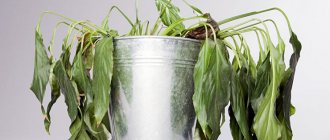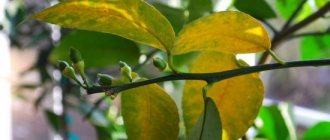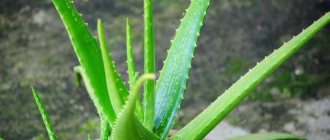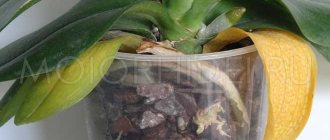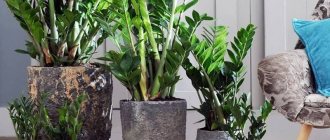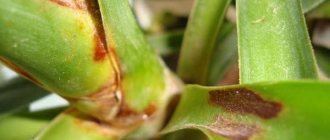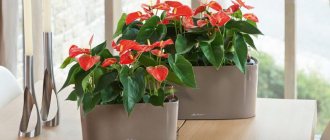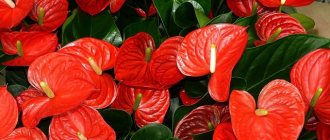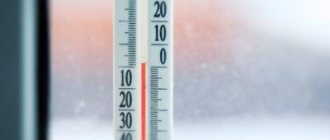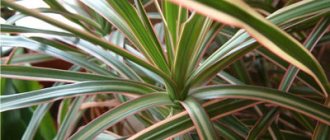Anthurium is an elegant indoor flowering plant that makes a great addition to any room. Another popular name is “male happiness.” Therefore, it is believed that in houses with this type of plant, representatives of the stronger sex will succeed and be happy. Although some people consider this flower to be fussy, it is easy to care for. It is enough to follow simple rules, and he will please the owner with his appearance. However, if you make a mistake in care, the plant will get sick. This can be determined by appearance. The appearance of yellow leaves is the first sign of problems. It is worth finding out how to determine the cause of yellowing and whether you should always worry, and also, if anthurium leaves turn yellow, what to do about it.
Anthurium pests
Of course, diseases that affect flowers, roots and leaves of a plant are often caused by pests.
Despite the fact that anthuriums do not get sick very often, and are generally slightly susceptible to the influence of various pests, it is important to know how to deal with them if they do damage the plant. Most often, anthurium is exposed to scale insects and aphids, as well as mealybugs. The scale leaves behind brown plaques on the plant, usually on the stems. Leaves may also be affected, becoming sticky and gradually losing their rich color. If the infestation is severe, the leaves dry out and fall off. Fighting scale insects is quite simple. Using a simple sponge soaked in soapy water, wipe the leaves of the plant. Spraying with Actellik solution (15%) will not be superfluous either. Maintain a proportion of 1 ml per 1 liter of water.
Aphids are known as the most common plant pest. In anthurium, it damages the top of the shoots, as well as the bottom of the leaves, flowers and buds. How to determine if a plant is infected? Infection manifests itself as leaves becoming discolored and suddenly curling. After this, the leaves turn yellow and quickly fall off. In addition, a sooty fungus forms on aphid secretions. You can fight aphids by spraying with inta-vir and decis, as well as actellik.
Mealybugs typically attack shoots, flowers and leaves. For example, spots form on the leaves, after which the foliage dries out and falls off. As a result, the anthurium may die. Flowers become dull and weak. You can fight scale insects by wiping the surface of the plant with a soapy sponge and washing it under a warm shower. If the damage is very severe, spray the anthurium with Actellik solution or Karbafos.
Please note that some folk remedies are also suitable for combating the pests listed above. For example, onion infusions and tobacco solution. A mixture based on grated soap with the addition of garlic and water in the following proportions will also help: five large spoons of garlic and soap per glass of water.
Why does the foliage dry out and turn yellow at the edges?
The most common reasons:
- insufficient watering;
- dry air;
- overheat;
- incorrectly performed transplantation;
- incorrectly selected soil.
If the leaves turn yellow and dry out at the edges, this is most likely a consequence of insufficient and irregular watering or too dry air. In order to save the plant, it is enough to normalize the watering schedule and start spraying the anthurium regularly. You can also place the pot in a tray with wet expanded clay to increase air humidity.
Incorrectly selected soil, which can also cause yellowing of the leaves, will have to be replaced. If the roots were damaged during the transplantation process, it is necessary to create the most favorable conditions for the anthurium and help it recover (for example, using a root formation stimulator).
Other problems due to improper care
- Dark spots and dots appeared on the leaves. Your pet may be cold. Move it to a warmer and brighter place. Do not water more often than required.
- The leaves turn yellow, their edges dry out. Perhaps the flower came under direct sunlight and got burned. Remove the pot from the sun or shade the blinds and create diffused lighting.
- The tips of the leaves have turned black. It is possible that an excess of nutrients has formed in the soil, in particular calcium salts. Repot your anthurium in new soil with a potting mix suitable for it.
- The leaves turn yellow and wither. The room temperature may be below comfortable. The optimal temperature during the growing season is 22 - 25 degrees, during the winter dormancy period 16 - 18 degrees.
- Lack of flowering. There are many reasons: low light, poor soil, large pot, low humidity and others. Read about the reasons for the lack of flowering in anthurium in the corresponding article on our website. Eliminate these causes and enjoy lush blooms for many years to come.
- Anthurium leaves turn black. There are several reasons. Perhaps the water you use for irrigation is too hard; perhaps the water is too cold; Perhaps it is chlorinated and did not have time to settle. Or perhaps you are not removing excess water from the pan. It stagnates there, and this provokes rotting of the roots. Soften hard water with a drop of lemon juice or acetic acid. The water must have a temperature not lower than room temperature and be settled. Water infrequently, but thoroughly, so that excess water seeps out of the drainage holes at the bottom of the pot into the tray. After some time, remove the water from the pan.
- Anthurium leaves turn yellow in a number of other cases: soil waterlogging; lack of soil in the pot, roots stick out; drafts, lack of lighting; bad water for irrigation; poor soil; unsuitable ambient temperature for the season. Analyze your conditions for keeping a tropical guest, eliminate the errors - and everything will return to normal.
- Anthurium leaves curled into a tube. Perhaps too bright lighting provoked the anthurium to turn on its defense mechanism. Place your flower out of direct sunlight and the leaves will unfurl again.
- Black spots appeared on the flowers. Perhaps you sprayed your plant carelessly and large drops of water fell on the flowers. Spray the plant carefully with a fine sprayer, avoiding getting on the flowers. Another such embarrassment occurs when the soil mixture is incorrectly selected for the flower - there is a lot of calcium in the soil. Such soil will have to be replaced.
- Thickenings and tubercles appeared on the roots of the anthurium. This means that the anthurium was affected by root nematodes. This disease cannot be cured. Destroy the plant along with the pot.
Timely transplant
If the above conditions are met and the problem remains, the cause of yellowing may be a cramped pot in which the plant has been “living” for several years and there is simply not enough space for the roots. Most likely, the soil in it has already been depleted, has become harder, and does not allow moisture to pass through well. For this reason, the leaves of anthurium turn yellow. What to do in this case? The tips are as follows:
- The flower should be carefully transplanted into a larger pot without damaging the roots.
- Be sure to place drainage at the bottom of the container so that air and water pass through the soil.
- Choose a special soil: loose, fibrous, acidified. It is advisable to carry out replanting with protective gloves, since the plant is poisonous and its juice can cause irritation to the skin.
Excessive dry air is the cause of dry anthurium leaves
Similar symptoms can be seen in anthurium placed in a room with dry air. Most often, this reason makes itself felt at the beginning of the heating season, when the plant’s usual conditions change, and aerial roots and foliage can no longer obtain the required amount of moisture from the air.
Why do anthurium leaves turn yellow in this case? They simply don't have enough food. Yellowness spreads from the edges of the leaf blades to the center, then the tissue on the tips and edges of the anthurium leaves dries. Young leaves developing in dry air often cannot unfold properly and are deformed or damaged.
You cannot do without additional air humidification, and you can achieve the humidity required by anthurium of about 70–85% using a household humidifier, as well as improvised means. The plant responds well if the tray is filled with fine expanded clay and filled with water. The pot is placed on the filler so that the roots do not have contact with moisture.
This means you will have to change the watering schedule. It is improper soil moisture under a houseplant that most often provokes the formation of brown spots, dry areas and yellowness on the leaves of the anthurium.
Possible reasons
To begin with, we note that yellowing and falling leaves do not always indicate improper care of the flower. The fact is that this flower has the natural ability to shed old leaves and shoots growing from below - this is necessary so that the flower can build up strength for the appearance of young leaves. However, in most cases, the reasons are still related to violation of the rules for growing this unusual flower.
If yellowness appears at the very edges of the leaf blades, then this is clear evidence of damage to the roots by various rots; this often happens when the flower is over-watered and the soil becomes waterlogged.
If yellow spots appear on the lower tier, then most likely the plant received too many nutrients, which led to a chemical burn of the roots.
The tips of the leaves may also turn yellow due to too cold indoor air. As you know, anthurium reacts very negatively to drafts; they pose a particular danger in the cold season.
By the way, if you water an anthurium with too cold water, this also causes a change in the color of the leaf plates. The roots of this exotic plant are very delicate and do not tolerate even the slightest violation of the optimal temperature regime.
If yellowing leaves are accompanied by the appearance of holes, this most often indicates an attack by pests. They begin to feed on the green parts of the plant, cutting small holes around which the leaves begin to turn yellow. Holes can also appear as a result of fungal pathology - in this case, a yellow spot first forms, then the tissue inside it dries out and begins to die, forming a hole visible to the eye.
How to care for anthurium?
To prevent the leaves from turning yellow and the flower from getting sick, you need to properly care for the anthurium. First of all, pay attention to the quality of the water with which you water the flower. Water should only be used at room temperature (or 2 degrees higher).
After each watering of the anthurium, be sure to remove the remaining water from the pan - this is necessary so that the roots of the flower do not rot. Be sure to change the size of the pot as the anthurium grows, otherwise it will be crowded and the flower will soon die.
Since the flower is exotic, it loves warmth, but does not tolerate drafts. Therefore, make sure that there are no drafts in the room where the flower is located, but at the same time there should be a regular flow of fresh air. Remember that anthurium needs to be fed: in summer, feed the flower once a week, and in winter – once or twice a month.
- Provide the flower with good lighting or partial shade. There should be enough light for the anthurium flowers to be bright and beautiful. Just try not to expose the flower to direct sunlight.
- Choose a suitable heat and humidity regime for the flower, then it will not hurt.
- In summer, the air temperature should be no lower than 18 degrees Celsius, and in winter and autumn – 15-16 degrees. If you want your anthurium to bloom faster, in January you can increase the temperature to 25 degrees.
- In the summer, try to water the flower abundantly, but do not overdo it. Spray anthurium leaves with boiled water as often as possible.
If you follow all these rules, the anthurium leaves will not turn yellow, and the flower will grow and delight you with its beautiful flowers.
Errors when replanting Anthurium
The capricious plant requires proper transplantation. After purchase, be sure to replant it in soil with a special composition. For the development of Anthurium, loose soil with maximum permeability for water and air is provided.
Its existence is due to the presence of an acidic environment, so the presence of peat is mandatory. When replanting, the soil is shaken off and dead roots are cut off. In the new pot, a drainage layer of 1/3 is provided, after which the plant is planted with the roots sprinkled with substrates. The fragility of the roots requires caution and the absence of compaction of the soil.
The ideal time for transplantation is spring. When the plant becomes older than 4 years, the number of replantings decreases to 1 time every 3 years. If you choose a different time of year, the flower will experience severe stress, after which it will quickly die.
If you don’t want to bother with the dosages of the components, purchase ready-made soil in the store. A substrate for orchids can be used by adding turf soil with charcoal. If you choose the wrong soil, Anthurium will die. Soil disinfection is important. To do this, cool in the cold for 3 hours or keep in the oven for 20 minutes at 200 degrees.
It is important to take care of the material of the pot. You should not choose clay, otherwise the flower will begin to sprout, and the roots will be damaged when replanting. If the owner wants the plant to develop quickly and correctly and side shoots remain. Flowering is possible only after separating the shoots and replanting them in a smaller pot. The flower loves the sun and warmth, but exposure to direct rays is contraindicated.
Changes in care that will help get rid of yellowness
If all the conditions for caring for “male happiness” – as anthurium is popularly called – are met, then the plant blooms gratefully and pleases the eye. Its flowers, formed on long cuttings, are distinguished by a large inflorescence that protects the stamen and is shaped like a heart. The color of the petals can be very different - from red to white. There are varieties with black flowers. The presence of yellow spots spoils the decorative appearance of the flower and can lead to its death.
The temperature of the water with which you water your indoor flower should be 2-3 degrees higher than room temperature, and if it is low, then it is advisable to dilute the settled water before watering with warm boiled water. Watering should be plentiful, but not excessive. The water formed in the pan after moistening the substrate must be drained to prevent rotting of the roots.
Adult branches of “male happiness” are replanted every year in spring. Light soil with good air circulation is ideal for filling the pot. The substrate can consist of equal parts of earthen and turf soil with the addition of a small amount of sand and peat.
You need to choose the “right place” for the pot. The flower should not be in the shade, but southern windows are not suitable for it either. It is best to place it in well-lit rooms next to, rather than on, window sills. Place the flowerpot on a shelf, stand or regular cabinet.
Large, yellowish-brown spots are the result of excess fertilizer and high concentration of mineral elements in the fertilizer.
How to treat a plant?
Any change in pigmentation on the leaves in most cases indicates the presence of some kind of disease or uncomfortable living conditions for this flower.
Actions to save anthurium directly depend on the reason that caused its wilting. Let's look at the main ones.
- Excess moisture. In this situation, it is necessary to change the watering regime of the anthurium as quickly as possible. Irrigation should be fairly moderate, but regular. For watering, you should use only soft water (filtered, melted or settled) - tap water contains chlorine and metal impurities, and is therefore harmful to the flower.
- Lack of lighting. Place the plant on east and west windowsills. In the winter season, be sure to use additional lighting - for this, special phytolamps with a yellow spectrum of lighting are used, however, ordinary fluorescent ones are also suitable.
- Lack of substrate. Transplant the flower into a larger pot so that the container is replenished with soil mixture.
- Pest attack. Aphids and mealybugs are especially dangerous for this flower. To get rid of them, you need to wash off all the parasites with a solution of laundry soap, then treat the green parts of the plant and the surface of the earth with a special insecticide.
- Hypothermia. In spring, anthurium is often taken out onto the balcony, but one should not forget that at night the air temperature is quite low, and the plant can freeze very much. In this case, yellow spots immediately appear on its foliage and it dies. In the same way, the plant reacts to ventilation of the room, if in winter the vents and windows are opened for this purpose.
It is important not to create conditions in which anthurium can “catch a cold.”
- Exposure to direct sunlight. This happens if the plant is placed on a south window. It is better to use other directions for this. But if this is not possible, then try to darken the flower - for example, use a small screen or stick a protective reflective film on the glass. Better yet, place it in a flowerpot, flower stand, or on a desk near the window.
- Fungal infection. In this case, you need to start resuscitation as early as possible. To do this, remove all damaged leaves, replant the flower and treat it with a suitable fungicidal solution.
The treatment is repeated several times every two weeks. If the plant is affected by more than 2/3, it cannot be cured.
Anthurium leaves turn yellow after transplantation. How to properly care for a flower?
Air humidity. Anthuriums require high air humidity. It is advisable to spray the leaves (but not the flowers) with warm, settled water every day. Beautifully flowering species tolerate dry apartment air better than decorative leafy species. To maintain the latter, special conditions are required (mini-greenhouse, greenhouse, florarium).
The soil. Like all aroids, anthurium needs light, slightly acidic soil. You can purchase a ready-made specialized mixture or prepare the substrate yourself. To do this, take 50% universal soil (with humus and high-moor peat) and 50% additives (a mixture of coke fiber, pine bark, vermiculite, coal, perlite, sphagnum moss). During the mixing stage, the ingredients are slightly moistened. Such a substrate will allow air to pass well to the roots.
Fertilizers are applied during the growth period of the plant. Use complex mineral fertilizer, reducing the concentration indicated in the instructions by 4 times.
Very often, yellowing of the leaves signals the gardener about problems in the root system of the anthurium. Excessive watering and hypothermia lead to the appearance of rot and the development of fungal and bacterial diseases. What to do?
- the plant is pulled out of the pot and the soil is very carefully shaken off
- the roots are carefully examined
- rotten roots are removed to healthy tissue with a sharp knife, the sections are sprinkled with crushed activated carbon and dried
- the plant is transplanted into a new pot according to the size of the updated root system (i.e., smaller in diameter than the previous one)
- adjust the conditions of keeping anthurium
- affected leaves are removed
- the roots are trimmed to healthy tissue and treated with a fungicidal preparation. wrapped in damp sphagnum moss and placed in a transparent cup with drainage holes
- in the greenhouse the plant is not watered; the cover is removed daily for 15-20 minutes for ventilation
when the plant gets stronger, it is transplanted into permanent soil
If, after replanting, the anthurium leaves begin to turn yellow, this may indicate damage to the root system during replanting, excessive flooding, incorrect choice of soil, or the plant’s normal adaptation to new soil. Anthuriums are replanted every 1-2 years. Regular replanting is necessary in order to renew the depleted soil and allow the root system to grow.
When replanting, special attention should be paid to the choice of pot. It is strictly forbidden to plant anthurium in a large pot at once.
The container must be selected according to the volume of the root system and increased by one size with each transplant (so that a finger fits between the old earthen lump and the edge of the pot). In a large pot, the soil will not have time to dry out, which again can cause stagnation of water and rot of the roots. Good drainage at the bottom is required. Knowledgeable gardeners do not recommend watering aroids for at least 3 days after transplantation. You can organize a greenhouse for the plant and regularly spray the leaves.
In addition to the rot of the root system, which has already been mentioned, anthurium is susceptible to leaf spot - anthracnose. This serious disease is treated with benomyl-based fungicidal preparations (use according to instructions). Damaged leaves must be removed and destroyed.
Thus, the key to a beautiful and healthy appearance of anthurium is proper care. The main rules that must be followed: warmth, absence of drafts, proper soil, tight pot, diffused light, regular moderate watering.
Anthurium belongs to plants of the arum family, or, in other words, aroids. Perhaps this is the most numerous genus of this family, because some types of anthuriums today number nine hundred different subspecies. They differ in the shape of the flowers and their color, the leaves of each type also have their own special shape and color.
Translated from the Latin name of the genus, anthurium means “tail” or “flower”. Sometimes the plant is called flamingo flower. Anthurium has a rather dense, glossy cover of leathery texture. The flowers are typically heart-shaped and range in color from soft pink to deep red. At first glance at anthurium flowers, you might think that they are made of plastic - this feature distinguishes it from other plants.
Description of the plant
Anthurium is an evergreen plant belonging to the Araceae family. Comes from the tropical forests of South and Central America. In nature, a flower can exist in different forms:
- epiphytes living on trees and feeding using aerial roots
- lithophytes that have adapted to life on rocks, etc.
ground
Anthurium has thick stems, short or elongated depending on the type of plant. The leaves are usually leathery, matte or glossy. The shape of the leaves is varied: round, spatulate, heart-shaped. The inflorescence is a spadix of small flowers, around which the so-called spathe is wrapped. It can be various shades of white, green, pink, red and even purple.
Because of this appearance, the plant is called “flamingo flower.”
In indoor culture there are both decorative leafy species (crystal anthurium, Hooker, Veitch) and beautifully flowering ones - the most popular among gardeners are Andre's anthurium and Scherzer's anthurium.
Anthurium pests
Small midges (wine flies) often become uninvited guests of indoor flowers; although they are unpleasant, they are practically harmless; the appearance of the following insects sucking juice from anthurium is much worse:
- Aphid. It is usually introduced “from the outside” with other plants and spreads very quickly among indoor flowers. For treatment, wash the affected areas with soap and water, after covering the soil with a bag, treat with infusion of onions (15 grams of finely chopped onions or 6 grams of dry scales are infused in 1 liter of water for 5-7 hours), Fitoverm, and in advanced cases - Actellik, Karbofos , Fitoverm, Iskra, Biotlin.
- Thrips. Thin midges up to 2 mm long. Suck the juices out of the leaves. Appears in a humid room at high temperatures. Treat with Fitoverm, diluting according to the instructions on the package. Treatment is carried out several times every 5–7 days.
- Spider mite. Appears in dry and hot places. It entangles young shoots in a web, sucks juices from leaves, leading to the death of most of the leaves. It is better to immediately apply Fitoverm, and not only on the affected plant, but also to treat neighboring plants for prevention.
- Mealybug. White fluffy insect 4–5 mm long. When massively propagated, it leads to the death of the plant. Small colonies of the pest are removed by wiping the affected parts of the plant with a soap solution and then every 7-10 days with repeated procedures, as well as spraying with garlic infusion. Severely damaged plants are sprayed with Fitoverm.
Pests in the photo
Prevention of the appearance of any insects is regular care of plants, wiping leaves from dust, quarantining new plants for two weeks.
Pests interfere with normal life activities
When such a problem occurs, flower owners should carefully examine the leaves, stem, and root zone for possible pests. Most often, the plant is attacked by a variety of mites, scale insects, aphids, scale insects and other insects. If anthurium leaves turn yellow for this reason, what should a gardener do? The procedure is as follows:
- Remove insects and their larvae by washing the flower with water.
- Treat the plant and root zone with a soap solution.
- Apply an insecticidal mixture, after which the plant must be washed well, since drugs of this type are quite toxic.
In some cases, repeated treatment with chemicals will be required, since after two to three days some pests, such as spider mites, hatch young. For prevention, the procedure should be repeated after another week.
To improve the effect in pest control, after treatment, you need to tightly close the flower for a couple of hours with a plastic bag. Insect control must be carried out in a timely manner, as they can easily spread to other indoor plants, and then it will be much more difficult to deal with them.
Anthurium resuscitation
Even if the anthurium has lost all its foliage, this is not a reason to get rid of it.
Living anthurium rhizomes can still be revived
First of all, you should find out what caused such a deplorable condition - improper care, disease or pests. Next you need to do the following:
- get rid of the contaminated soil, since it most likely contains spores of parasitic fungi or insect eggs;
- turn the pot into heat treatment, boil for 5 minutes in water with soda.
If these preventive procedures are not carried out, the young regrown leaves of anthurium will become a welcome delicacy for newly hatched parasites. A disease introduced with the soil can destroy a weakened plant. Therefore, it is very important to disinfect new soil in any available way:
- Steam treatment. The soil is laid out on a fine-mesh mesh over boiling water for 30–40 minutes. This is a labor-intensive but very effective method.
- Freezing. The soil is kept at sub-zero temperatures for a week, then brought into a warm room to thaw. This is a lengthy process and is easiest to carry out in winter, when you can use a balcony as a freezer.
- Potassium permanganate. This is a method for the lazy. All you need to do is spill the soil with a raspberry solution of potassium permanganate and wait 30–40 minutes for the soil to dry.
The main stages of anthurium resuscitation
- For disinfection, the remaining rhizome without leaves should be soaked for 30–40 minutes in light pink potassium permanganate, and then placed in Kornevin solution for 3–4 hours. The drug stimulates the development of roots; it contains phytohormones that promote the accelerated development of the root system of plants. This procedure will allow the anthurium to quickly cope with the stress of transplantation and accumulate strength for the growth of new young leaves.
- While the rhizome is “soaking,” it is necessary to prepare new soil for the plant. You can use ready-made mixtures for aroids or prepare the substrate yourself. The soil should be light enough and contain peat, sphagnum, vermiculite, charcoal and bark. Sphagnum moss in the soil not only retains moisture, but also has bactericidal properties. Vermicompost will provide the soil with the necessary microflora. Vermiculite accumulates excess moisture and releases it to the plant as needed. The soil also needs to be “filled” with fertilizers for indoor flowers.
- After this, the rhizome can be planted in a pot with prepared soil. The roots need to be sprinkled with the substrate, lightly tapping the pot so that the soil is compacted. The anthurium should not be deeply buried; the root collar should remain above the surface of the substrate.
- There is no need to water the anthurium before active growth begins; just spray the soil surface. It is advisable to cover the flowerpot with a plastic bag; it can be removed when the first young leaf appears. Then the plant requires normal care.
Video: rules for transplanting anthurium
Anthurium feels great in our apartments. But you should be very attentive to his needs and take timely measures to prevent possible diseases. If you care for the plant correctly, the anthurium will delight you with the brightest flowers of the most exotic colors throughout the year.
Features of caring and growing anthurium
Anthurium does not need any special care, but the basic requirements still need to be met. Improper maintenance of the plant can lead to problems with its health, which can cause the beautiful appearance of the flower to suffer.
Important! Vital conditions for growing anthurium are the absence of drafts and remote placement from heating devices.
We are talking about the following requirements:
- Lighting. The flower needs good diffused lighting, without direct sunlight. Despite the fact that in nature the plant is shade-tolerant, intense shading will not contribute to successful development and flowering. Therefore, location on a northern window sill is a bad decision for culture. But a western or eastern window is the best option.
- Temperature. The plant is thermophilic: in winter the mercury should not fall below +16 °C, and in summer the ideal value would be +28 °C.
- Humidity. A tropical resident really needs high humidity, therefore, to maintain it, it is necessary to install an air humidifier in the room. It is also suitable to place it near a flower in an aquarium or a home fountain, or you can place a flowerpot with anthurium in a container with wet pebbles. Spraying the air space near the crop will also be important (the flower itself is not specially moistened, since water drops can leave lime marks on the leaves and “spreaders” of the flowers).
- Leaf care. The leaves of the flower need to be periodically wiped with a dampened rag, and also provided with water treatments, pouring warm water on top of it and washing off the dust deposits (without irrigating the inflorescences themselves). At the end of the procedure, the remaining water must be removed with an absorbent wipe.
- Watering. The plant needs abundant watering, but waterlogging is also undesirable. Water the anthurium only after the top layers of soil in the pot have dried.
- Soil mixture. The substrate is preferably light and nutritious. Purchased soil intended for aroid crops is suitable, as well as well-drained soil, since stagnant moisture can cause root rot.
- Feeding. Fertilize the crop in the spring-summer period 2 times a week, using fertilizers for aroid plants (the concentration should be halved). Sometimes, along with watering, foliar fertilizers are applied to the flower.
- Bush rejuvenation. In the process of life activity, the growth of new leaves in a plant is accompanied by the death of old ones. To prevent the flower from losing its decorative effect, it must be rejuvenated. For this purpose, the top of the plant with several internodes must be cut off and placed in water to take root, or placed directly in damp vermiculite.
However, when caring for anthurium, you may encounter yellowing of its foliage and loss of decorativeness.
Next we will talk about the possible causes of this phenomenon, as well as how you can save the flower from such problems. Did you know? The Latin name of anthurium (Anthúrium) is borrowed from the ancient Greek language and means “flower with a tail.”
Diseases and pests that cause leaves to turn yellow
Often the problem is caused by harmful insects. The appearance of small yellowish or brown dots can warn of a spider mite attack. In this case, you should immediately check the lower surfaces of the shoots. If the suspicions are justified, then you will notice a sticky white coating on the back of the sheet plates.
Caring for anthurium is not too difficult. It consists in the correct watering regime and protecting the plant from drafts and low temperatures. By following the basic rules, you can decorate your home with a charming “men’s happiness” flower.
Anthurium is the cherished dream of many gardeners, but if not properly cared for, this capricious and very sensitive plant can experience many problems. The most common of these is the appearance of yellowness on the leaves. If you do not pay attention to it in time, the flower may die. However, before you take measures to save your pet, you should find out what exactly led to the yellowing of the anthurium leaves.
Preventive measures
The lower leaves of phlox turn yellow: what to do
One of the main precautions is to regularly check for diseases and insect pests on anthurium. This will allow you to detect the first signs of a problem in time. It is also recommended to carefully follow the care instructions.
It is important to create the best and most suitable conditions for a comfortable life for plants. If traces of the disease are found on the surface, it is necessary to isolate the plant from other flowers to prevent spread. Compliance with precautionary measures will prevent the deterioration of the anthurium’s condition, allow you to quickly detect troubles and heal the flowers.
Yellowing of anthurium leaves can be caused not only by disease or improper care, but also by natural processes inside the flower. If this problem is discovered, you need to find the true cause, and then act immediately, do everything possible to save your house plants.
Ideal conditions - and no problems with leaves
Moving off the shelves, the ideal anthurium bushes at home often begin to change. In fact, this is just a symptom of the fact that anthurium, like any other indoor plant, needs careful selection of conditions, attention and routine care.
Anthurium leaves often lose their decorative appearance and turn yellow if the correct periods of adaptation are not organized, which are “shown” to this beauty not only after purchase, but also after replanting or rearranging. But the wrong selection of conditions also causes problems with leaf colors.
For anthurium, the key conditions for stable decorativeness are:
- stable temperature with protection from extreme heat and cold (the minimum permissible values even in winter are 15 degrees Celsius);
- diffused light, without direct sunlight or strong shading (most modern varieties prefer bright light rather than partial shade);
- absence of drafts and sudden temperature changes;
- high or at least average air humidity;
- soil selected specifically for anthurium (loose, nutritious, with a rough texture, neutral reaction, not compacted over time) and high drainage at the bottom of the pot.
The main thing in caring for anthurium is to check the condition of the soil and follow a fertilizing schedule with frequent, but not too concentrated fertilizing. Regular replenishment of nutrients in the soil and watering, allowing the top layer of the substrate to dry out, but not allowing drought and extremes, is an almost complete guarantee that you will not have to observe yellowing leaves on anthuriums.
If you create ideal conditions and care for the anthurium, there will be no problems with the leaves.
What to do
In order for Anthurium to drop its leaves and not die, it is necessary to strictly monitor the lighting, do not leave it in direct sunlight, and in winter add ultraviolet light. Only warm air temperature without drops or drafts. To achieve high humidity, additionally spray the plant with warm water. Use complex mineral fertilizers, paying special attention to concentration volumes.
Often, a change in leaf color indicates a problem with the root system. Therefore, an unscheduled inspection of the flower is carried out, a transplant is carried out and corrective measures are taken. Only after the tropical miracle has grown stronger can it be moved to permanent soil for further cultivation.
The worst reason is the appearance of spider mites. To prevent development, spraying with a special solution is carried out, and the use of acaricides is allowed. After normalization of the condition, the flower is transferred to a new and more spacious place of residence.
Diagnosis of diseases of “male happiness”
All problems of growing anthurium can be divided into leaf diseases, peduncle diseases, root diseases, and the general unsatisfactory condition of anthurium, which are caused by the presence of pests, infectious diseases, or simply errors in care.
Making a correct diagnosis and starting timely treatment is a difficult task for a gardener, since the symptoms of various diseases are often similar to the consequences of improper care.
It is important to know that anthurium kept in a dry room most often suffers from spider mites; the leaves lose their elasticity from lack of moisture, turn yellow and curl, but these plants are very rarely affected by fungal and bacterial diseases. In humid conditions without ventilation, plants more often suffer from soil overflow, and as a result, they suffer from infectious diseases
In humid conditions without ventilation, plants more often suffer from soil overflow, and as a result, they suffer from infectious diseases.
Having assessed the condition of your premises and the care provided, you can more or less accurately decide how to help the anthurium.
Prevention measures
We found out why anthurium leaves turn yellow. What should I do to avoid this? Use the advice of experienced flower growers:
- Often it is enough to follow basic care rules, ensure the required temperature and humidity level.
- Regular feeding and replanting have a beneficial effect on growth and flowering.
- Preventive measures to disinfect the soil will help prevent the appearance of fungi and insects.
- Regular examination will make it easier to identify foci of the disease and help eliminate them in a timely manner.
Fungal diseases
Anthurium is often subject to various fungal diseases, which can lead not only to its yellowing, but also to death. A flower shop, close proximity to a diseased plant, contaminated soil or an unsterile pot can become sources of infection. High room temperature and excess humidity are a favorable environment for further growth of bacteria.
Fungal diseases of anthurium:
- Gray rot is a disease caused by excess moisture. The leaves turn yellow and become covered with a gray coating formed by small white sporangia. When the microspores turn black, the plant begins to rot. If a disease is detected, it is necessary to stop spraying and watering and treat the flower with a fungicide, after first replacing the top layer of soil in the pot. Anthurium infected with gray mold requires immediate isolation from other house flowers. If treatment with antifungal drugs does not help, the diseased plant must be destroyed.
- Septoria is a disease caused by Septoria fungi. It is characterized by the appearance of multiple yellow spots on the leaves. At the initial stage of the disease, when there are isolated cases of damage, the plant can be saved. Anthurium is sprayed with fungicides, diseased leaves are removed. If no action is taken, the yellow spots grow, turn brown, and then dry out, leading to the death of the plant. Septoria, like anthracnose, is brought from the store.
- Anthracnose. The causative agents of the disease are imperfect fungi that reproduce in the soil. The source may be contaminated soil in a pot and the proximity of diseased plants. High humidity and high temperature favor the progressive course of the disease. A sign of anthracnose are gray spots on the leaves surrounded by a yellow border. At the initial stage, you can stop the disease without resorting to destroying the flower. The affected leaves must be removed, and the plant must be treated with fungicidal preparations. It is necessary to eliminate conditions favorable for the proliferation of fungi: reduce the number of waterings and sprayings, ventilate the room, it may be necessary to transplant into another pot and replace the soil. For prevention, neighboring plants are treated with copper oxychloride.
- When rust occurs, light yellow marks appear on the upper side of the leaves, and the underside becomes covered with pustules - brown spots with spore powder. Extensive damage to the anthurium will cause the flower to dry out completely. Treatment when the first signs of rust are detected consists of removing damaged leaves, treating the plant with a solution of foundationazole and disinfecting the soil with potassium permanganate.
- Fusarium is a fungal disease that first causes massive yellowing and falling off of anthurium leaves, then the death of the stem. The fight against the disease is complicated by the fact that the flower becomes infected through the soil. The infected plant noticeably bends to one side, and the stem at the base darkens, becoming covered with a light coating of Fusarium fungal spores. To prevent Fusarium wilt, after purchase, the anthurium should be transplanted into a clean flower container using a disinfected soil mixture.
The fight against infectious diseases of anthurium is not easy. It may not be possible to save the flower; the main task is to isolate other plants, prevent further spread of bacteria and carry out preventive measures by checking every leaf.
Photo
In the photo you can see what the yellow spots on the leaves of Male Happiness look like:
This is a photo of a plant whose leaf tips are drying:
Anthurium diseases
Anthurium leaves turn yellow due to infectious, fungal diseases and in case of damage by various types of pests.
Fungal diseases
Downy mildew also causes yellowing, with leaves becoming smaller and internodes shortening and wilting. A characteristic sign of this disease is the formation of a gray coating with sporangia on the inside of the leaf.
Fusarium is diagnosed by the following signs: first the leaves turn yellow, then wither and fall off. Due to the fact that the base of the stem darkens and dies, the diseased plant leans to one side. This type of fungus is almost impossible to exterminate, so the plant must be thrown out along with the pot.
Root rot, as the name suggests, damages the roots of anthurium due to stagnation of moisture in the soil. Rotten roots cannot deliver nutrients to the plant itself, causing the leaves to gradually turn yellow and fall off, and the plant dies.
Pests
As can be seen from all of the above, there are practically no reasons why leaves turn yellow that cannot be corrected. Your task is to detect the disease in a timely manner and correctly diagnose the signs of disease.
In any case, your efforts, care and proper treatment will help cope with the problems of maintaining and caring for this plant. And the tropical “Latin American” anthurium will again delight you with beauty and health.
Anthurium or male happiness attracts the eye thanks to its magnificent inflorescences, painted in the brightest colors of the spectrum: red, purple, yellow, pink, blue. The glossy leaves of anthurium are also decorative, and some varieties are distinguished by a silvery frame of the veins. Anthurium is considered an unpretentious plant, but for beautiful flowering and growth it needs certain conditions. If your plant looks sickly, analyze the errors in the maintenance and eliminate them, guided by our tips.
Diseases associated with activation of fungi
The tropical flower is moisture-loving. Trying to maintain humidity at the proper level, we simultaneously create a favorable environment for the development of harmful fungi. They multiply quickly in a warm and humid environment, infect leaves, which become covered with yellow and brown spots, gradually dry out and die. The most typical fungal formations:
- Septoria - brown formations on the foliage, edged with a yellow rim. The leaves die over time, and after a certain time, if there is no action, the plant itself dies.
- Anthracnose - leaves dry out and become thinner.
- Downy mildew - yellowish spots on the surface of the leaf, grayish spores on the inside
- Stains with a hint of rust.
One of the main signs of fungal diseases in anthurium is yellowing leaves. What to do if these symptoms appear?
First, reduce the humidity. Secondly, treat the soil and the plant itself with a fungicidal preparation. Bordeaux mixture is very effective, especially in the fight against septoria. Thirdly, do not forget about preventive measures and periodically treat the soil with special protective preparations.

